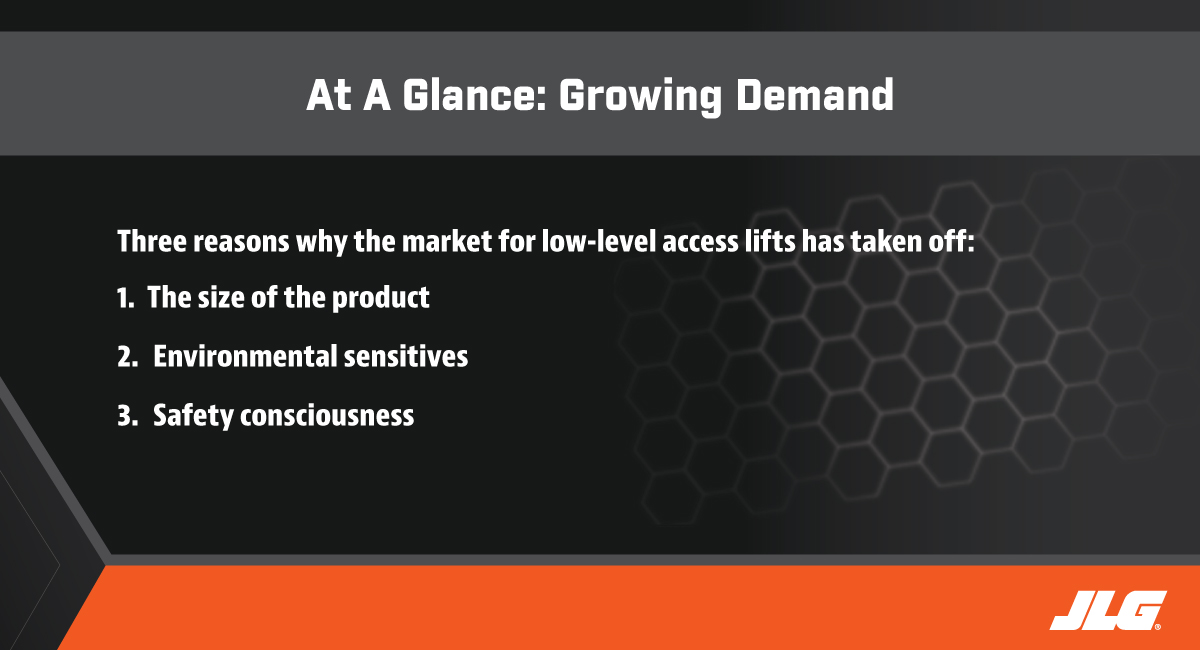 Misty Mason
Misty Mason
Product Manager, Low Level Access
____
JLG Industries
Popularity for low-level access lifts has grown rapidly in the last couple of years, and we see the market for low-level access continuing to increase, hitting a new market inflection point as this type of equipment becomes more widely adopted in applications that traditionally have used ladders or scaffolding.

There are three reasons why the market for low-level access lifts has taken off: 1) The size of the product; 2) environmental sensitives; and 3) safety consciousness.
Let’s take a closer look at each of these to better understand what’s going on with this trend…
#1: Size matters on job sites
Because these types of machines are lightweight and compact in size, and they can be pushed into place or between work areas and require minimal storage space, they are ideal for use in a wide variety of applications. With less open space, and buildings getting taller and narrower, there is a greater need for products that have a small footprint, are lighter weight for use on sensitive flooring and can fit into and moved between floors in elevators for ongoing facility maintenance, from airports and data centers to high-rise buildings — and just about anything in between.
Additionally, because of their size and weight, they are also well-suited for fit-out and finish work on construction sites, such as painting, installing fire alarm or sprinkler systems, putting in (or replacing) lighting and dropping in ceiling tiles. Other common applications for low-level access lifts include refitting retail displays and updating seasonal décor, as well as maintaining production equipment in manufacturing environments.
This equipment also features portability benefits. Low-level access equipment can be lowered and moved from one location to another to perform multiple tasks throughout a facility in less time.
#2: Increased environmental sensitivities
These MEWPs (mobile elevating work platforms) are also gaining favor among companies focused on eco-friendly solutions and sustainability. Human- and battery-powered lifts run quieter, as well as eliminate or reduce emissions altogether, making them suitable for use everywhere from clean rooms and data centers to hospitals, schools, libraries and office buildings where noise restrictions exist.
#3: Becoming more safety consciousness
The demand for these lifts continues to grow as companies place more focus on replacing ladders and scaffolding in the workplace. Ladder falls and overuse injuries as the result of ladder use have many negative outcomes. In addition to employee injury, falls can lead to lost time, reducing productivity and costly workers’ compensation claims. Those who are actively seeking alternative solutions find that low-level access lifts are more ergonomically efficient to operate, more productive to get work done and can be used to improve safety in place of ladders and scaffolding. That’s because low-level lifts are designed and purpose-built to reduce strain on the body and lessen the risk of musculoskeletal injuries caused by repetitive movements, such as climbing up and down a ladder.
The rapid rise in workplace injuries and fatalities driving the need for change, and safety-conscious companies, including JLG’s parent company Oshkosh, are committing more and more to the elimination of ladders when another alternative exists.
Leading the way
For more than a decade, JLG’s parent company, Oshkosh Corporation, and its brands, including JLG, have been actively working towards eliminating falls from ladders in its proactive pursuit of the highest level of OSHA’s Voluntary Protection Program (VPP). The company had made positive progress in improving workplace safety through the implementation of its robust Safety Management System. But then, a preventable injury from a ladder fall led Oshkosh to say “no more.”
Since then, Oshkosh has been implementing five steps within all of its facilities to eliminate ladder falls. To learn more, download the whitepaper “5 Steps to Reach Zero Falls From a Ladder.”
Evolving product offerings
For many OEMs, including JLG, as companies like Oshkosh are looking to replace ladders with low-level access lifts, there has been a focus on increasing the product range of this equipment to address the growing list of jobs to be done up to 20-ft.
JLG, for example, most recently introduced its 1030P model, a push-around model that offers a 10-ft 2-in platform height, is 30-in wide and weighs just 755-lbs. This lightweight machine is designed with a compact footprint to push into place. It is ideal for use in place of scaffolding during both the finishing and regular stages of construction requiring a working height up to 16-ft. Its 30-in x 60-in platform, 550-lbs platform capacity allows for ample tools and materials to be brought to the workspace, thereby reducing user fatigue associated with ascending and descending a ladder. And, its lightweight design, in combination with a low ground-bearing pressure, makes the 1030P perfect for use on floors or in elevators with limited load requirements.
Other advancements in this type of equipment have been focused on enhancing the operator’s experience through productivity-focused features, such as the inclusion of tool trays for the convenient storage of tools at height, the addition of saloon-style doors and a step for access into and out of the platform. And in the case of the JLG EcoLift™ series, the development of a patented stored-powered lift/lower system eliminates the need to charge a battery during or between shifts.
Increasing awareness
Ladders and scaffolding have been around for a long time. People are very comfortable with them, though also understand the risks involved in their use. In fact, the market for low-level access equipment is influenced by three contributing factors when choosing low-level access equipment over ladders or scaffolding: Safety, Productivity and Ergonomics. All three of these factors are becoming increasingly more important with the rapid rise of labor rates, workers’ compensation and an aging workforce.
In addition to manufacturing this type of equipment, JLG has also worked to increase the awareness of low-level access lifts as alternatives to ladder use. As companies consider using low-level access equipment as an alternative to more traditional ways of completing work at height, our advice is simply that end-users need to give these products a try. Rent one, then get feedback from employees on the comfort and effort level versus using a ladder. If employees feel more confident when using these products, we recommend doing a productivity study to determine if the rental or purchase of a low-level access lift makes sense for your business.
Interested in learning more about low-level access equipment solutions? JLG has a full library of content available on-demand at
JLG.com, on
#DirectAccess and on
YouTube. To get started, click
here.
Do you want to stay up-to-date with industry news and issues similar to this? Make sure you subscribe below to receive monthly updates from #DirectAccess with newly posted content so you never miss important information.